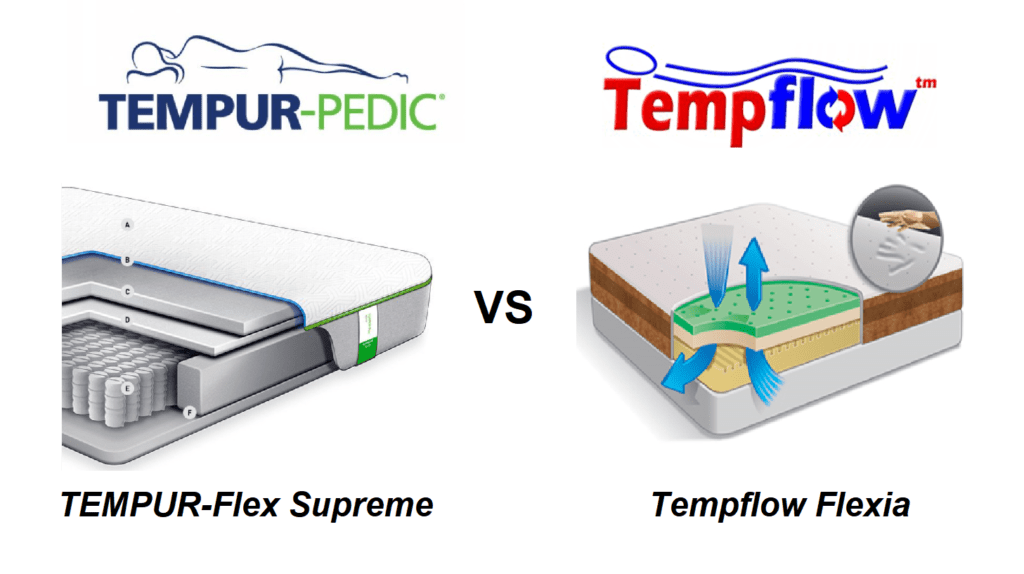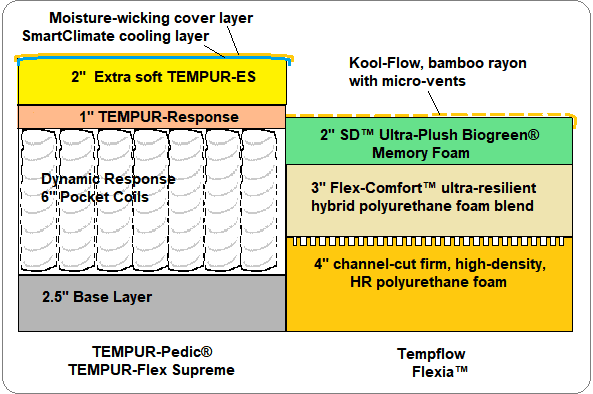
Two Comparable Models
The Flexia by Tempflow is regarded as comparable to the TEMPUR-Flex Supreme by TEMPUR-Pedic, the second model in the TEMPUR-Flex Collection. One is a hybrid, the other is not. They are different heights, with 9” for the Flexia, and 11.5” for the Supreme. The commonality for which they are comparable is their feel, medium-firm with a soft top over resilient support. They appeal to the same shoppers.
Each model has two layers of visco-elastic foam on top. TEMPUR-Pedic calls theirs “TEMPUR Material,” while Tempflow (like almost everyone else) calls theirs memory foam.

Key Materials
TEMPUR-Pedic claims to have a unique material, not just memory foam. There is a basis for this claim. This is the company that introduced memory foam mattresses to the world with the name “Swedish Tempur Foam” (based on the temper foam label the lead NASA engineer used for the new material), and their foam is still very high quality. The TEMPUR Material for North America is made here in the United States, and for Europe it is made in Europe. It is not made in Asia, as are so many other memory foams. Their foam is one of the reasons why TEMPUR-Pedic mattresses are still the standard to which other memory foam mattresses are compared.
Tempflow’s memory foam is also made in the USA, and is also very high quality foam. The foams have been specifically formulated for Tempflow and its parent company Selectabed. The foams were engineered to meet the specifications of Dr. Rick Swartzburg, a chiropractor, who is the chief designer of Selectabed mattresses.
Support in TEMPUR-Pedic hybrid mattresses (including those in the new TEMPUR-Adapt and TEMPUR-ProAdapt collections) is pocket coils, while in Tempflow mattresses it is high resilience polyurethane foam.
TEMPUR-Pedic also has a 2.5” base “layer” (pad) under the coils, as well as foam edge support around them. The base is extra firm polyurethane foam, while the edge support is not as firm.
Construction
TEMPUR-Flex Supreme and Tempflow Flexia Construction
| TEMPUR-Flex Supreme | Tempflow Flexia™ | |
| Fabric Cover | 2 layers of polyester-spandex blend. Upper one has wicking fibers, lower one has SmartClimate treatment. | Kool-Flow, bamboo rayon with micro-vents, part of Airflow Transfer System. |
| Top Layer | Comfort Layer: 2″ of Extra-soft TEMPUR-ES® Material | Comfort Layer: 2″ of SD™ Ultra-Plush Biogreen® Memory Foam |
| Second Layer | Response Layer: 1″ of quick-responding TEMPUR-Response™ material | Flex-Comfort Layer: 3″ of Flex-Comfort™, an ultra-resilient hybrid polyurethane foam (blend of memory foam conformity and latex-like springiness) |
| Support Core | 6″ high pocket coils, 2070 count in King size. Has foam edge support around perimeter. | 4″ of firm, high-density, HP polyurethane foam |
| Base Support | 2.5″ of extra firm polyurethane foam | n/a |
The construction of the two models is similar. Each has a soft top layer and a firmer, resilient second layer, with the support core as the third layer. However, the heights of these layers differ between the two mattresses, but it is the 2.5” base pad that accounts for the difference in total height, 11.5” for the TEMPUR-Flex Supreme, and 9” for the Flexia.
Kool-Flow Fabric Covers
The covers differ in their composition and construction. The top panels of on both mattresses are zippered for removal and washing.
The TEMPUR-Flex Supreme has two layers, each a blend of polyester and spandex, each with a different treatment. The top layer includes moisture-wicking fibers to keep the sleeping surface dry, and the lower layer has the “SmartClimate System” treatment to make it cool to the touch.
The cover of the Tempflow Flexia is Selectabed’s Kool-Flow fabric of rayon from bamboo which is micro-vented to let air flow through for cooling. This is part of the patented Airflow Transfer System (ATS).
Top Layer
The memory foam in the top layers of both mattresses is very soft: 2” of “Extra-soft TEMPUR-ES® material” in the TEMPUR-Flex Supreme, and 2” of “Ultra-Plush Biogreen® Memory Foam” in the Tempflow Flexia. The advantage of this is a faster, softer response when the sleeper lies down. Being visco-elastic memory foam, the material goes on to conform to the sleeper’s body contours and weight, relieving pressure, yet the faster response means that the foam will adapt to the new position more quickly when a sleeper moves than the denser memory foam valued for its deeper conformity and pressure relief.
TEMPUR-ES is the 4-lb less dense foam developed by TEMPUR-Pedic in response to complaints about (1) slow initial conformity of the 5-lb foam when the mattress was still cool, and (2) overheating. This was also part of the original memory foam mattress company’s response to Dr. Swartzburg’s development of the Tri-Pedic Mattress. This became the signature foam for the TEMPUR-Cloud Collection.
Biogreen memory foam, developed by Selectabed, is not plant-based, and makes no claim of that. It has been developed to be toxic-free and to have a much lower level of volatile organic compounds (VOCs) than other foams. Tested in a UL lab, Biogreen was found to have 1/13 the VOCs allowed by GreenGuard Gold, the strictest certification standard.
Second Layer
The second layer of each mattress has been engineered for resiliency. The descriptions of the foams by both companies make these sound like latex-like foams. This kind of foam in this position serves two purposes. First, it is firm enough to support the memory foam, not let it bottom out, leading to its breaking down. Second, it puts a little bounce into the mattress. Combined with the soft memory foam, this yields a weightless feel. This layer is 3” high in the Flexia, but only 1” thick in the TEMPUR-Flex Supreme. The reason for this difference could be because the TEMPUR-Pedic model has pocket coils below, while the Flexia has a foam support core. The coils need a bit more height for the same support and flexibility.
Support Core
As mentioned above, the TEMPUR-Flex Supreme has pocket coils for support, and the Tempflow Flexia has HD HR foam. Both offer motion isolation and conformity. And both offer airflow, but by different means.
Pocket coils are not tied to each other, but are in fabric pockets. This means they respond individually to weight placed on them. First, this means even support. Second, since one coil does not pull down the next, it stops motion transfer, reducing or eliminating partner disturbance.
As to airflow, coils are open, so air can flow through them and through the fabric of the pockets. However, to cool the top of the mattress, the air needs to go though the layers of foam. While these layers are vertically ventilated in the TEMPUR-Flex Supreme Breeze, they are not in the TEMPUR-Flex Supreme. Open-cell foam, which is now standard for memory foam, does allow some air to filter through the foam, but ventilation lets seven times as much to flow through.
In the Tempflow Flexia, channels are cut into the top surface of the support core foam. With the micro-vents in the cover (top and sides) and vertical ventilation of the upper foam layers, warm air can freely flow down through the mattress and out through the sides, and cool air can flow the other direction.
Demonstration Video
Base Layer
Of these two models, only the TEMPUR-Flex Supreme has a base pad/layer. Base pads are a standard feature on pocket coil mattresses. This is because the coils need support underneath, since they are not linked together. The base pad on the T-Flex Supreme is much higher than those of most other brands, which average from ¾” to 1” in thickness. It seems that TEMPUR-Pedic has an additional role in mind. They do say it helps disperse heat, but they don’t say how.
Also, the T-Flex has foam walls for edge support. This is because pocket coils in general need side support to hold them in place. Some newer pocket coil brands now use stronger fabric to hold the coils in place while putting stiffer coils around the border for edge support. Such edge support is not needed in the Flexia, with the firm foam support core and high quality foam above.
Warranty and Sleep Trial
There is a notable difference between TEMPUR-Pedic and Tempflow in their warranties and sleep trials, and these apply to the TEMPUR-Flex Supreme and the Tempflow Flexia. The older company lowered its warranty for all new mattress sales to 10 years non-prorated a few years ago, while Tempflow warrantees its mattresses for 40 years. The difference is not quite a large for the sleep trial: TEMPUR-Pedic for 90 nights, and Tempflow for 120.
Customer Ratings
Until remaining models are sold out (this model is being phased out), Amazon has reviews for the TEMPUR-Flex Supreme (these are shared with TEMPUR-Flex Prima). There are only 45 of them – older reviews are not available – with an average rating of 4.1 Stars (82%).
Reviews for Tempflow and its mattresses are in the 32 reviews on Yelp for the Selectabed/Tempflow/Air Pedic store in Agoura Hills, California. Of these, only 11 are for Tempflow and its mattresses. Three of the mattresses are not named: Flexia, Celestia, and Gaia, but the overall ratings indicate the likely ratings for Flexia. Of these 11 rating, 10 are 5 Stars, and one is 3 Stars. The average rating is 4.82 Stars (96.36%).
Comparison of features for TEMPUR-Flex Supreme vs Tempflow Flexia
Tempurpedic® TEMPUR-Flex Supreme | Tempflow Flexia™ | |
| NASA Memory Foam | ✔ | ✔ |
| Warranty | 10-Year | 40-Year |
| Sleep Trial | 90-Night | 120-Night |
| Over 5lb. Density Memory Foam | ✔ | ✔ |
| Medium Feel | ✔ | ✔ |
| Made In the U.S.A. | ✔ | ✔ |
| Patented Airflow Circulation Through both Sides and Surface | X | ✔ |
| Biogreen GreenGuard Tested Memory Foam | X | ✔ |
| Extra Supportive | ✔ | ✔ |

